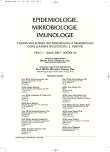-
Medical journals
- Career
Notified Cases of Imported Transmisssible Infections in the Czech Republic
Authors: J. Dlhý; Č. Beneš 1
Authors‘ workplace: Krajská hygienická stanice Královéhradeckého kraje se sídlem v Hradci Králové ; Státní zdravotní ústav, Praha 1
Published in: Epidemiol. Mikrobiol. Imunol. 56, 2007, č. 1, s. 23-32
Overview
Objectives:
Based on analysis of epidemiological characteristics, to determine trends in the incidence of imported transmissible diseases in the Czech Republic and to draw attention to the epidemiological significance of international tourism and migration.Material and methods:
In cooperation with the National Reference Centre for Epidemiological Data Analysis, National Institute of Public Health Prague, the nationwide Epidat information system databases from 1993 to 2005 were analyzed using software Epi Info version 6.04d.Results:
Between 1993 and 2005, altogether 12,091 cases of transmissible diseases were imported into the Czech Republic from 168 countries in the world. The notified annual incidence of imported infections ranges from 206 to 1,714 cases. The highest percentage of cases was imported by Czech tourists (50.7 %) while 40 % of the notified cases were imported into the Czech Republic by foreigners. The period 1998–2004 for which the data on Czech tourism to other countries are available is characterized by increase in the absolute number of imported cases while the relative incidence of imported cases per 100,000 population traveling to other countries shows a downward trend. The highest numbers of cases were imported from Viet Nam (1,258 cases), Slovakia (1,155 cases) and India (786 cases). When considering Czech tourism to other countries for which the corresponding data are available, the highest rates of imported diseases in 1998–2004 were linked to the travels to Tunisia (1.18 imported cases per 1,000 tours), Bulgaria (0.69 per 1,000 tours) and Turkey (0.65 per 1,000 tours). The leading diagnosis of imported cases was salmonellosis (22%), followed by campylobacteriosis (10%) and trichuriasis (8%).Conclusion:
Analysis of the Epidat information system databases for reporting transmissible diseases enables assessment of trends in imported infections in the Czech Republic as a point of departure for estimation of health risk from tourism and migration.Key words:
Epidat – analysis – trends – imported disease – transmisssible disease – tourism.
Labels
Hygiene and epidemiology Medical virology Clinical microbiology
Article was published inEpidemiology, Microbiology, Immunology

2007 Issue 1-
All articles in this issue
- Effects of Trace Elements on the Immune System
- Tetanus Immunity in the Elderly in the Czech Republic
- Microbial Biofilms in the Food Industr
- What are the Prospects for Medical Microbiology in the Next 20 Years?
- Notified Cases of Imported Transmisssible Infections in the Czech Republic
- Failures to Comply with the Routine Childhood Immunization Schedule Due to Contraindications and the Use of Alternative Vaccines in Children Aged 0–4 Years in the Czech Republic
- Pancreas Cancer Epidemiology
- Epidemiology, Microbiology, Immunology
- Journal archive
- Current issue
- Online only
- About the journal
Most read in this issue- Pancreas Cancer Epidemiology
- Notified Cases of Imported Transmisssible Infections in the Czech Republic
- Tetanus Immunity in the Elderly in the Czech Republic
- Microbial Biofilms in the Food Industr
Login#ADS_BOTTOM_SCRIPTS#Forgotten passwordEnter the email address that you registered with. We will send you instructions on how to set a new password.
- Career

